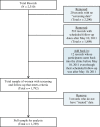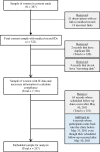Adherence to screening appointments in a cervical cancer clinic serving HIV-positive women in Botswana
- PMID: 30885175
- PMCID: PMC6423763
- DOI: 10.1186/s12889-019-6638-z
Adherence to screening appointments in a cervical cancer clinic serving HIV-positive women in Botswana
Abstract
Background: The link between human immunodeficiency virus (HIV) and cervical cancer is of particular concern in Botswana, where one in four women at risk for cervical cancer is HIV-positive. In settings where co-occurrence of these diseases is high, adherence to screening appointments is essential to ensure detection and early treatment.
Methods: This study took place in a cervical cancer-screening program in an HIV clinic in Botswana. Data for this analysis came from 1789 patient records and 257 semi-structured surveys about the screening consent process that were completed by a subset of patients.
Results: Forty percent of women kept their scheduled follow-up appointments. Findings suggest that women treated at first visit or referred for additional treatment due to the presence of more advanced disease had more than double the odds of adhering to follow-up appointments compared to women with negative screens. Women who completed the 35-min surveys in the embedded consent study were found to have 3.7 times greater odds of adhering to follow-up appointment schedules than women who did not. Factors such as age, education, income and marital status that have been shown elsewhere to be important predictors of adherence were not found to be significant predictors in this study.
Conclusions: HIV-positive women in Botswana who are symptom free at initial screening may be lost to essential future screening and follow-up care without greater targeted communication regarding cervical cancer and the importance of regular screening. Strategies to reinforce health messages using cell phone reminders, appointment prompts at time of anti-retroviral drug (ARV) refills, and use of trained community workers to review cervical cancer risks may be effective tools in reducing the burden of cervical cancer disease in HIV-positive women in this setting.
Keywords: Adherence; Botswana; Cancer screening; Cervical cancer; HIV.
Conflict of interest statement
Ethics approval and consent to participate
The study underwent ethics review by the Health Research and Development Committee of the Botswana Ministry of Health and Wellness and the Ethics Committee at Princess Marina Hospital in Gaborone; in the United States the study was reviewed by Institutional Review Boards at the University of Pennsylvania and Rutgers University. In addition, permission to conduct research at the Bontleng Clinic was received from the Ministry of Local Government in Botswana and the Gaborone City Council, which hasjurisdiction over the Bontleng Clinic and its patients. All patients gave their verbal consent to participate in the screening program and those who agreed to participate in the embedded consent study so indicated with written consent or witnessed verbal consent if they were unable to sign their names.
Consent for publication
Not applicable.
Competing interests
The authors declare that they have no competing interests.
Publisher’s Note
Springer Nature remains neutral with regard to jurisdictional claims in published maps and institutional affiliations.
Figures
Similar articles
-
Patient perspectives on delays in cervical cancer screening and follow-up care in Botswana: a mixed methods study.BMC Womens Health. 2022 May 28;22(1):195. doi: 10.1186/s12905-022-01777-z. BMC Womens Health. 2022. PMID: 35643491 Free PMC article.
-
Text messages to increase attendance to follow-up cervical cancer screening appointments among HPV-positive Tanzanian women (Connected2Care): study protocol for a randomised controlled trial.Trials. 2017 Nov 21;18(1):555. doi: 10.1186/s13063-017-2215-x. Trials. 2017. PMID: 29162148 Free PMC article. Clinical Trial.
-
Barriers to accessing cervical cancer screening among HIV positive women in Kgatleng district, Botswana: A qualitative study.PLoS One. 2018 Oct 24;13(10):e0205425. doi: 10.1371/journal.pone.0205425. eCollection 2018. PLoS One. 2018. PMID: 30356248 Free PMC article.
-
Cervical Cancer in Botswana: Current State and Future Steps for Screening and Treatment Programs.Front Oncol. 2015 Nov 3;5:239. doi: 10.3389/fonc.2015.00239. eCollection 2015. Front Oncol. 2015. PMID: 26579491 Free PMC article. Review.
-
Factors influencing cervical cancer screening in women infected with HIV: a review of the literature.J Assoc Nurses AIDS Care. 2013 May-Jun;24(3):189-97. doi: 10.1016/j.jana.2012.06.010. Epub 2012 Sep 20. J Assoc Nurses AIDS Care. 2013. PMID: 22999769 Review.
Cited by
-
Stage and outcomes of invasive cervical cancer patients in Botswana: A prospective cohort study from 2013 to 2020.Gynecol Oncol Rep. 2022 Oct 26;44:101094. doi: 10.1016/j.gore.2022.101094. eCollection 2022 Dec. Gynecol Oncol Rep. 2022. PMID: 36337265 Free PMC article.
-
Non-adherence to cervical cancer screening recommendations among women in Eswatini: a cross-sectional study.BMC Public Health. 2023 Feb 8;23(1):290. doi: 10.1186/s12889-023-15022-1. BMC Public Health. 2023. PMID: 36755260 Free PMC article.
-
Prevalence of Abnormal Cervical Lesions and Associated Factors Among Women in Harar, Eastern Ethiopia.Cancer Manag Res. 2020 Dec 3;12:12429-12437. doi: 10.2147/CMAR.S279712. eCollection 2020. Cancer Manag Res. 2020. PMID: 33299351 Free PMC article.
-
Distance to Multidisciplinary Team Clinic in Gaborone, Botswana, and Stage at Cervical Cancer Presentation for Women Living With and Without HIV.JCO Glob Oncol. 2022 Nov;8:e2200183. doi: 10.1200/GO.22.00183. JCO Glob Oncol. 2022. PMID: 36395437 Free PMC article.
-
Clinical and sociodemographic factors associated with late stage cervical cancer diagnosis in Botswana.BMC Womens Health. 2021 Jul 6;21(1):267. doi: 10.1186/s12905-021-01402-5. BMC Womens Health. 2021. PMID: 34229672 Free PMC article.
References
-
- Ferlay J, Soerjomataram I, Ervik M, et al. GLOBOCAN 2012 v1.2, Cancer incidence and mortality worldwide: IARC CancerBase no. 11 [internet] Lyon: International Agency for Research on Cancer; 2013.
-
- GLOBOCAN . 2012 v1.2, Cancer incidence and mortality worldwide: IARC CancerBase no. 11 [internet] Lyon: International Agency for Research on Cancer; 2013.
-
- Bruni L, Barrionuevo-Rosas L, Albero G, et al. ICO information Centre on HPV and Cancer (HPV information Centre). Human papillomavirus and related disease in Botswana. Summary Report 27 July 2017. https://hpvcentre.net/statistics/reports/BWA.pdf. Accessed 1 Feb 2018.
MeSH terms
LinkOut - more resources
Full Text Sources
Medical



